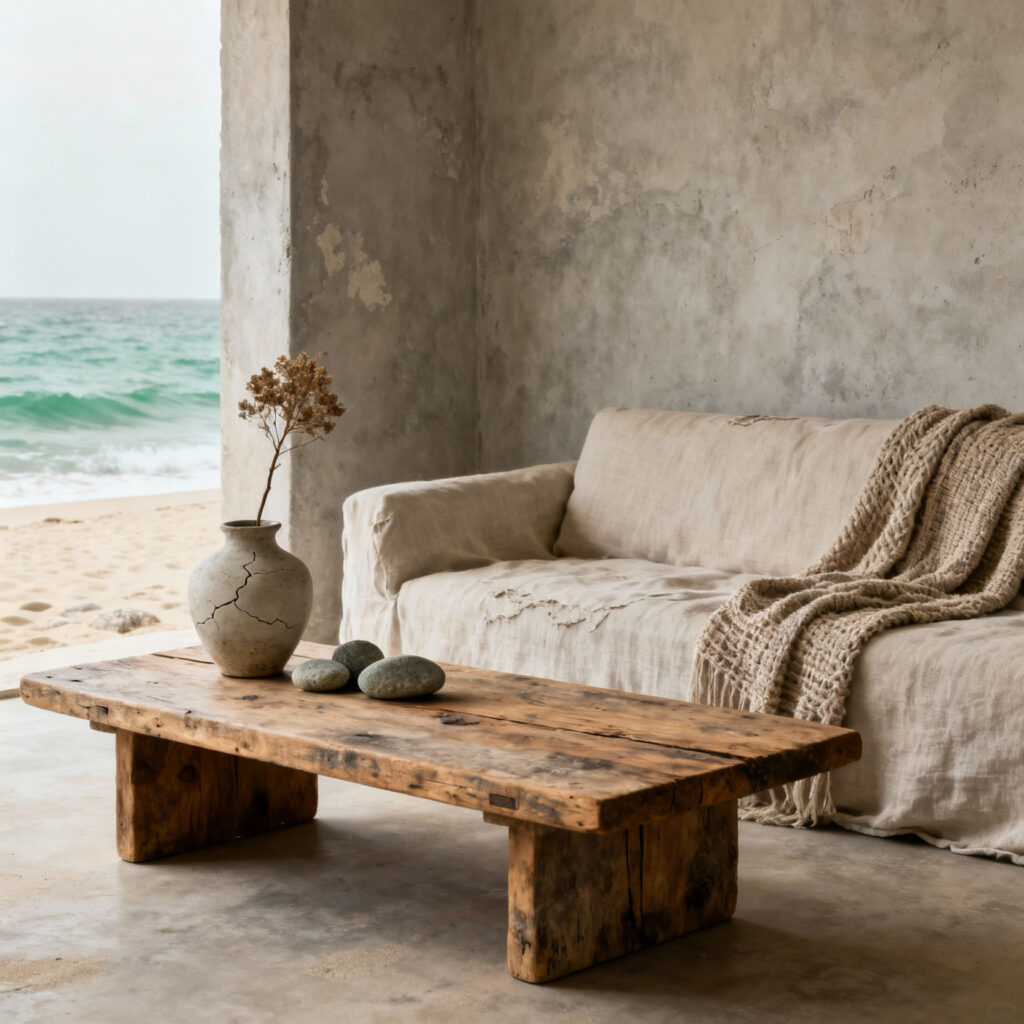Since the earliest traditions of Japanese architecture, space has been understood not as a void to be filled, but as a living presence—a medium for connecting humanity with nature. This philosophy evolved from the deliberate emptiness of our tea rooms and the borrowed scenery of our gardens into a timeless way of living. Today’s most sophisticated spaces understand this profound dialogue between what is there and what is not. The principles that separate a living room of serene, enduring harmony from one that is merely decorated have not changed in centuries.
A friend recently asked how these ideas—our concepts of ma and wabi-sabi—could possibly find a home in a coastal living room, a style so often defined by bright, thematic decor. The answer is that we are not seeking to replicate a theme, but to distill an essence. It is an exploration of how the quiet rhythm of the tide and the patient weathering of the shore can be felt in the balance of a room, the texture of its materials, and the way light moves through it. This is not about style; it is about cultivating a place for the soul to rest.
We will begin with philosophy, the unseen foundation of all good design. Then, we will move to the tangible—the materials you can touch and the way they speak of their origins. From there, we explore the arrangement of space itself, and how emptiness can be the most powerful tool. Finally, we arrive at how these elements come together to support a life of purpose and peace. This path from the abstract to the concrete will guide you in creating not just a beautiful room, but a true sanctuary.
Embracing the Spirit of Kai-Zen: Foundational Philosophies for a Harmonious Coastal Abode (Part 1)
To create a coastal living room that feels truly serene, we must begin not with objects, but with perspective. Here, we look at the core ideas that shape a space from the inside out, principles that allow a room to resonate with the quiet depth of both the ocean and a contemplative mind.
1. Cultivating Wabi-sabi: Finding Beauty in the Imperfect and Weathered
Wabi-sabi is the quiet acceptance of the transient and the imperfect. It teaches us to find a profound beauty in things that are humble, aged, and marked by time—a sensibility that echoes the very spirit of the coast. For your living room, this means inviting in materials that tell a story. Think of a piece of driftwood, its form smoothed and bleached by a long journey in the sea, or a handmade ceramic bowl with a slightly uneven glaze. These objects possess a character that perfection can never achieve.

In my experience with Japanese design principles, what truly brings wabi-sabi into a home is choosing materials that are allowed to live and age with you. A linen sofa that softens and creases with use, a wooden table that gathers small marks over years of shared meals—these are not flaws. They are evidence of life. Rather than striving for a pristine, untouchable space, this philosophy encourages us to create a comfortable, forgiving environment where the natural process of aging is seen as beautiful.
2. Mastering Ma: The Art of Deliberate Emptiness
The concept of ma is perhaps the most essential—and most misunderstood—principle in Japanese design. It is not emptiness, but rather an intentional space full of potential. Think of it as the pause in a piece of music that gives the notes their power. A room crowded with things, no matter how beautiful they are, has no room to breathe. Ma teaches us to value the space between objects as much as the objects themselves.

In a coastal living room, mastering ma means creating visual quiet. Instead of filling every wall and corner, you select only a few meaningful pieces and give them space. A single, sculptural lamp on an otherwise clear console table allows its form to be truly seen. An open expanse of flooring can feel as calming as an uncluttered mind. The goal is to edit, to subtract, until what remains is only the essential. This creates a sense of profound calm and spaciousness, allowing the ever-changing light from the coast to become a primary feature of the room.
3. Harnessing Shinrin-Yoku: Inviting Nature’s Restorative Presence Inward
The idea of shinrin-yoku, or “forest bathing,” is a reminder of our innate need to connect with the natural world for our well-being. While you may live by the ocean, not a forest, the principle is the same. It is about blurring the lines between indoors and out, creating a space that feels like a continuation of the natural landscape. This is more than just placing a few plants in a room; it’s about inviting nature’s sensory experience inside.

A coastal living room can achieve this by maximizing natural light, making the view the main work of art. Use sheer fabrics that filter light gently, rather than heavy drapes that block it. Incorporate materials that feel raw and elemental—stone, unvarnished wood, woven seagrass. The sound of a small, quiet water feature can mimic the distant sound of waves. What I tell my minimalism enthusiasts is to think about the feeling of being on a quiet beach at dawn. That is the tranquility we seek to bring into the home, a constant, gentle immersion in nature’s calm.
4. Articulating the Haptic Experience: Creating a Dialogue Through Texture
A space is not only seen; it is felt. The haptic experience—our sense of touch—is fundamental to how we perceive our environment. A living room designed with this in mind becomes truly immersive. It moves beyond a purely visual aesthetic to engage the body, fostering a deep sense of comfort and grounding. Think of the coast itself: the contrast between cool, smooth stones and coarse, sun-drenched sand.
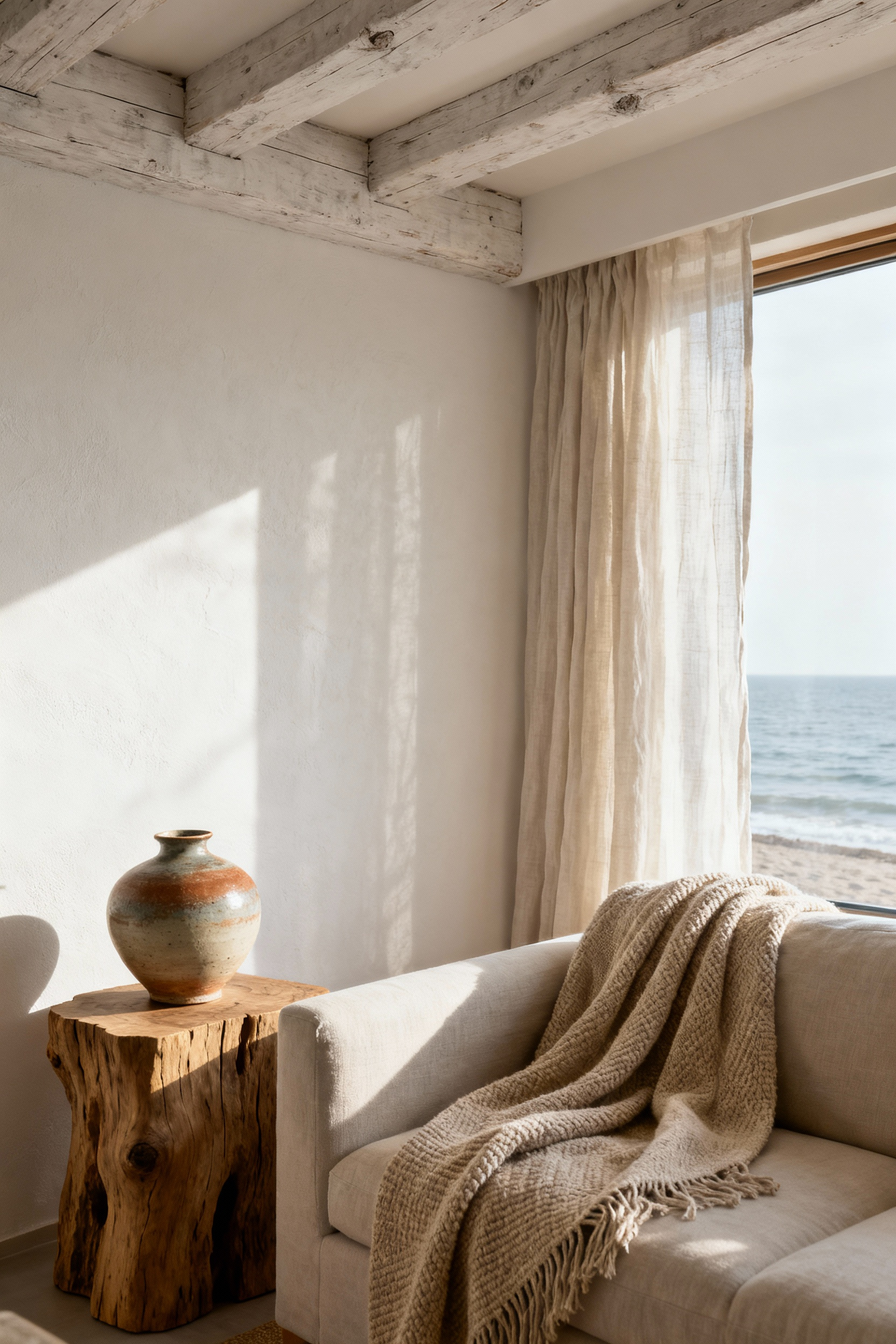
To bring this into your living room, focus on materials that invite your touch. A rough-hewn wooden mantel, a hand-knotted jute rug underfoot, a soft, nubby linen throw on the sofa. Each surface offers a different tactile story. This layering of textures creates a rich, sensory environment that is deeply comforting. It’s a space that feels honest and real—a place where you can truly settle in, connect with your surroundings, and feel at peace.
Embracing the Spirit of Kai-Zen: Foundational Philosophies for a Harmonious Coastal Abode (Part 2)
As we continue to build our foundation, we turn to color. But not in the conventional sense. Instead of a prescribed palette, we listen to what the coastal landscape itself suggests—its moods, its subtleties, and its quiet, enduring beauty. This is about evoking a feeling, not replicating a photograph.
5. Synthesizing Subtle Chromatisms: A Nuanced Palette Beyond Blue and White
The typical coastal living room often relies on a predictable pairing of bold blues and stark whites. But the true palette of the coast is far more subtle and profound. Years of working with natural materials taught me to look closer. Think of the quiet gray of a foggy morning, the countless shades of beige and taupe in dry sand, the pale, almost translucent green of sea glass worn smooth by the waves. This is the essence we want to capture—a nuanced palette that feels calm, layered, and authentic.

This is best achieved through materials rather than paint. Allow the natural color of unfinished wood, unbleached linen, and handmade ceramics to form the basis of your room. These honest materials carry their own subtle variations in tone, creating a rich visual texture that a flat wall of color never can. A piece of reclaimed teak will have whispers of gray and warm honey. An unglazed pot will have the earthy color of raw clay. These tones shift beautifully as the coastal light moves through the room during the day, creating a space that feels alive and constantly, subtly changing.
With this natural foundation, you can then layer in small, thoughtful touches of color. A cushion in a muted, storm-cloud blue; a vase holding dried sea grasses; a single piece of art with a splash of deep sea green. The key is restraint. This approach creates a serene, contemplative atmosphere. The colors do not demand your attention; they simply exist in harmony, allowing you and your thoughts to be the focal point of the space. This is a room that soothes the spirit rather than stimulates it, offering a true refuge from the visual noise of the outside world.
Tatami-no-Ura & Terroir: Textural Harmonies and Organic Forms in Coastal Design (Part 1)
Here, we ground our philosophy in the tangible. We explore the materials that form the body of the room, choosing textures and forms that speak of their origins—whether from the forest or the artisan’s hand—and that echo the elemental character of the coast.
6. Curating Sustainable Wood Finishes: The Elegance of Driftwood and Shou Sugi Ban
Wood is the soul of a Japanese-inspired space. In our tradition, wood is never just a surface; it’s a living history. For a coastal living room, we look for wood that speaks of its connection to nature. Aged driftwood is a perfect example. Each piece is a unique sculpture, shaped by the sea, its soft gray patina a testament to time and resilience. It brings an immediate sense of peace and organic history into a room, whether as a coffee table base or a single, contemplative object on a shelf.
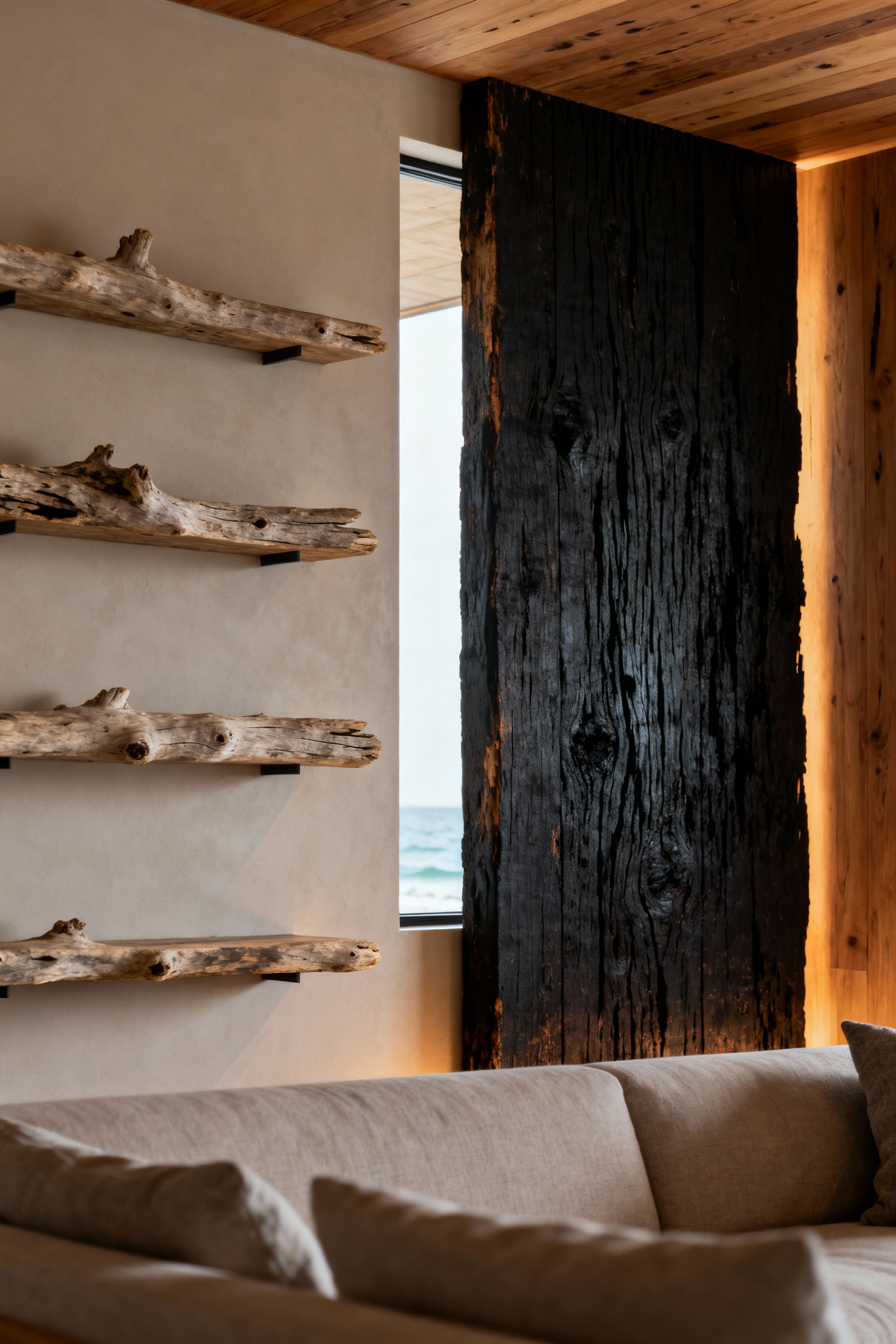
To complement the natural weathering of driftwood, we can turn to the art of Shou Sugi Ban. This traditional Japanese technique of charring wood creates a deep, carbonized black finish that is both stunningly beautiful and incredibly durable. The rich, almost reptilian texture absorbs light, adding a quiet depth and gravitas to a space. Years of traditional Japanese architecture taught me its value—it’s a method of preservation that becomes an aesthetic statement. A feature wall or a piece of furniture finished in Shou Sugi Ban provides a powerful, grounding contrast to the airy lightness of a coastal interior, creating a beautiful balance between shadow and light.
7. Integrating Raw Fibers and Woven Textures: Enhancing Depth and Acoustic Softness
After establishing the strength of wood, we soften the space with raw, natural fibers. This is where the quiet, understated beauty of shibui comes to life. We choose textures that are honest and unpretentious: the earthy feel of jute, the breathable comfort of linen, the subtle irregularity of hand-woven rattan. These materials connect us to the earth and to the craftspeople who made them.
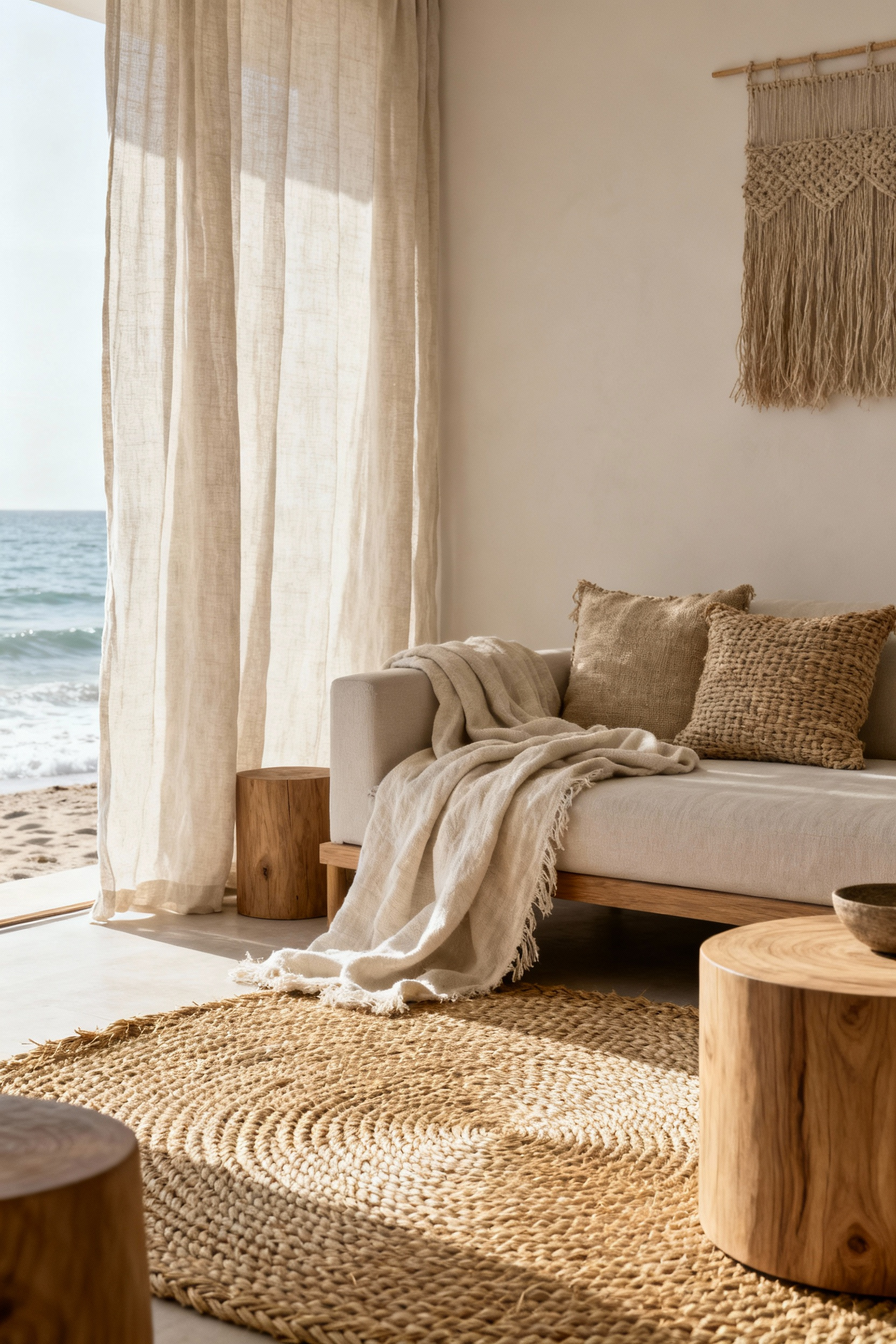
In a coastal living room, these fibers do more than just add visual warmth. A large jute or sisal rug underfoot not only grounds the space but also absorbs sound, creating an acoustically soft environment that feels instantly calmer. Linen curtains, left slightly crumpled, diffuse sunlight into a gentle glow—a phenomenon we call komorebi, the beautiful light that filters through trees. These woven textures create a rich, layered experience. I’ve noticed that when a room is acoustically quiet, our minds tend to follow, making the space not just visually pleasing, but truly restorative.
8. Selecting Ceramic and Stoneware: Evoking Primal Earthiness and Artisan Craftsmanship
To ground the airy lightness of a coastal room, we turn to the earth itself. The presence of ceramic and stoneware connects us to something ancient and elemental. We seek pieces that show the hand of the maker—the slight asymmetries in a hand-thrown bowl, the unique texture of an unglazed surface. These objects embody wabi-sabi; their perfect imperfections are where their soul resides.
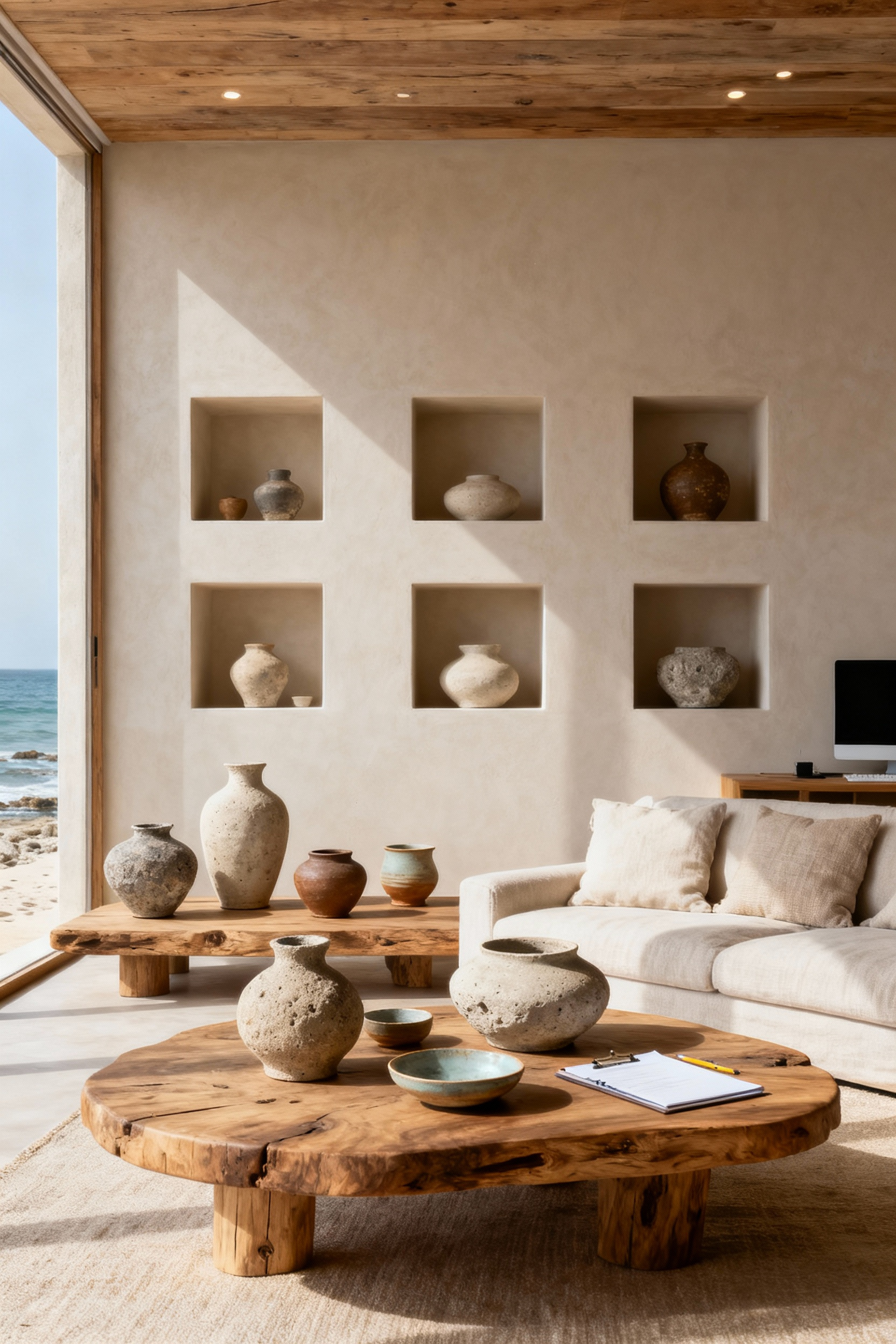
These earthen elements serve as points of quiet contemplation in the room. A large, sculptural stone vase holding a single, windswept branch can anchor an entire corner. A collection of small, handmade bowls on a shelf invites closer inspection. Even the daily ritual of drinking tea from a mug with a satisfying weight and texture can become a small, grounding moment. In Japanese design, we understand that these simple, authentic objects can hold great power. They remind us of our connection to the earth and to the long tradition of human craftsmanship.
9. Adorning with Translucent Elements: The Ethereal Dance of Glass, Shell, and Agate
While wood and stone provide grounding, translucent elements introduce a touch of the ethereal—like the play of light on water. This is not about adding sparkle, but about capturing and diffusing light in a gentle, almost poetic way. It’s a celebration of subtlety, of quiet glimmers and soft reflections.
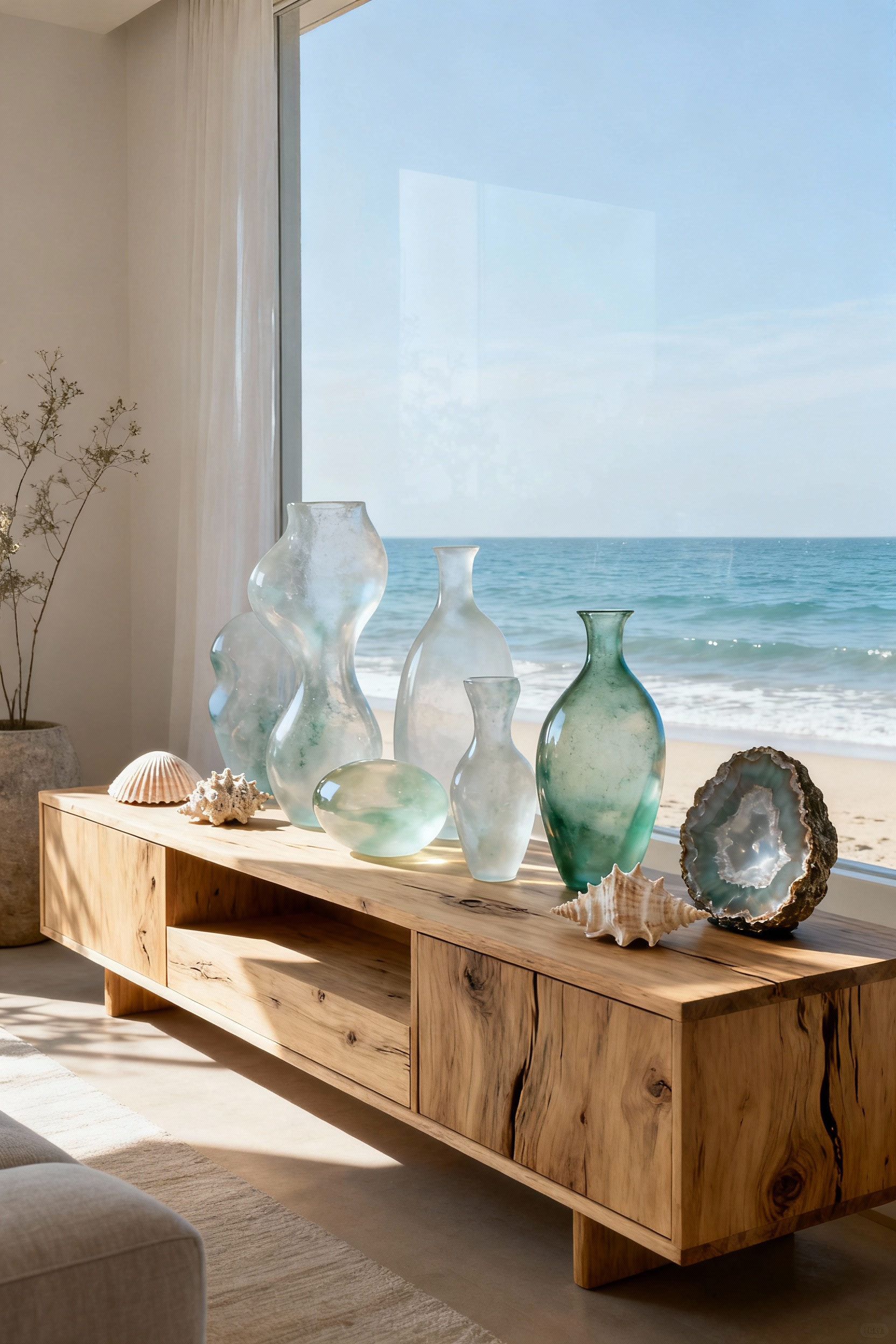
Our materials here are drawn directly from the shore. Sea glass, frosted and smoothed by its journey, captures light without glare. Polished agate slices reveal intricate, natural patterns when held up to a window. Even the subtle iridescence of a mother-of-pearl shell can add a beautiful, fleeting hint of color. These elements should be placed where they can interact with the natural light—a bowl of sea glass on a windowsill, a small agate dish on a side table. They create a delicate dance of light and shadow, adding a layer of ephemeral beauty that perfectly complements the enduring presence of wood and stone.
Tatami-no-Ura & Terroir: Textural Harmonies and Organic Forms in Coastal Design (Part 2)
As our understanding of materiality deepens, we consider an element that might seem out of place: metal. But approached with intention, it can offer a subtle gleam that enhances, rather than distracts from, the room’s tranquility, much like the unexpected shimmer of wet stone on a beach.
10. Employing Understated Metallics: Subtle Gleams of Brushed Brass or Antiqued Pewter
In a space dedicated to natural quietude, the use of metal must be thoughtful. It is not for opulence or shine, but for the way it can catch and reflect light with gentle warmth. The goal is hikari—a soft, subtle light-bringing quality. From my work in Japanese aesthetics, the key is to choose finishes that feel lived-in and have the capacity to develop a patina over time, embracing the philosophy of wabi-sabi.
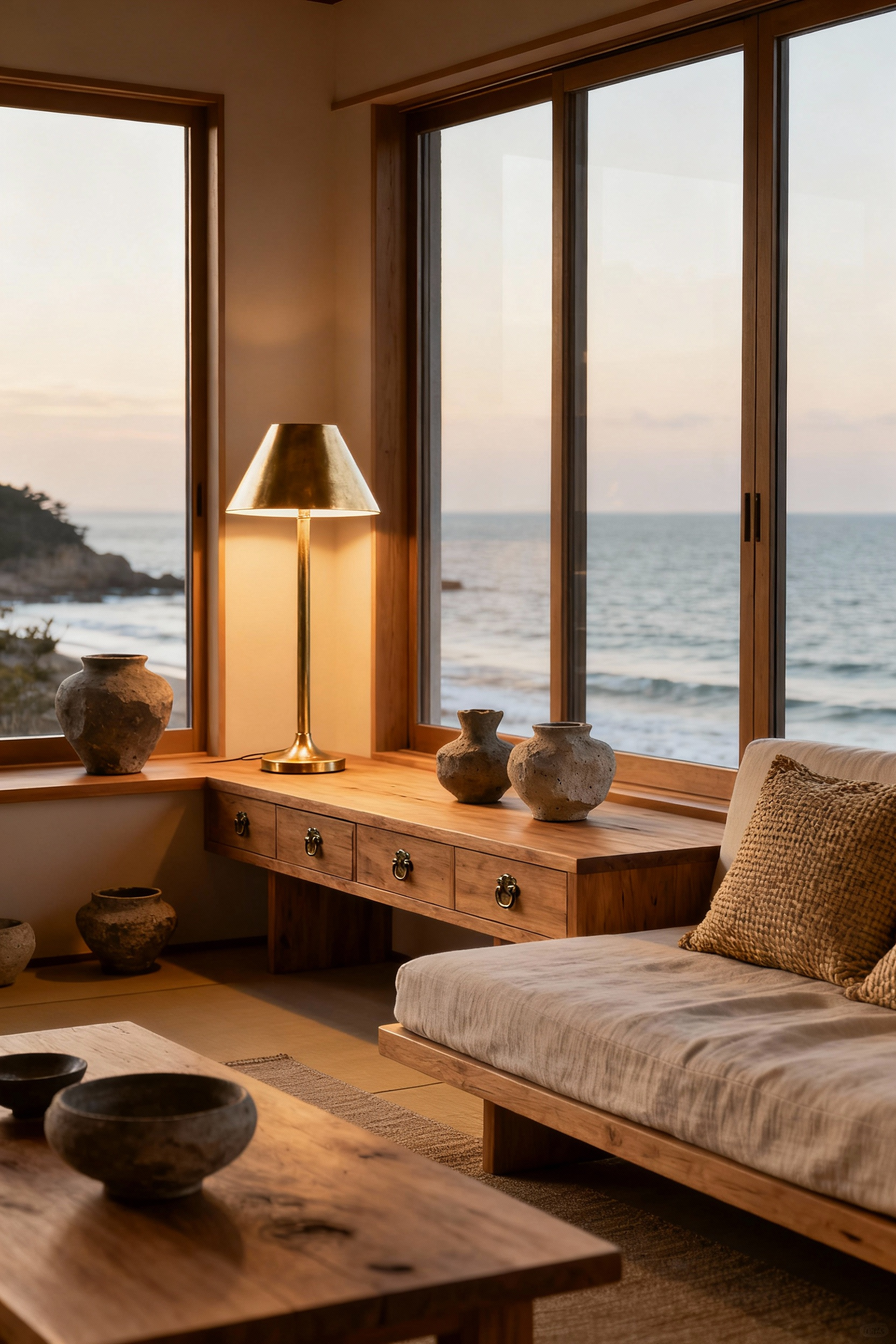
Brushed brass offers a muted, sun-like glow, avoiding the harshness of its polished cousin. It pairs beautifully with the warm tones of natural wood. Antiqued pewter, on the other hand, has a cooler, more contemplative quality, echoing the color of a stormy sea. These metals should appear as quiet details—the slender frame of a floor lamp, the hardware on a simple cabinet, or a delicate tray holding a few cherished objects. What really gets me is how these small, understated accents can subtly elevate a room. They introduce a different kind of texture and a quiet luminescence, like the moon reflecting on calm water, adding a final layer of refined elegance without ever raising their voice.
Ma and the Meyasubashi: Artful Delineation and Rhythmic Composition of the Coastal Living Space (Part 1)
Now that we have gathered our materials, we must learn to arrange them. This is about more than furniture placement; it is the art of composing space. Using the principles of Ma (the active void) and Meyasubashi (the guiding visual framework), we craft a room that directs the eye, calms the mind, and flows with a natural, peaceful rhythm.
11. Optimizing Light’s Presence: Architecting How Illumination Moves and Breathes
Light is not just a utility; it is a material in itself. In Japanese architecture, we don’t just let light in; we guide it, shape it, and celebrate its ever-changing nature. This is the heart of a coastal living room—a space defined by the unique, brilliant light of the sea. Our goal is to architect its presence, creating a dynamic play of brightness and shadow, kageri, that animates the room throughout the day.

We achieve this with sheer, natural fabrics like linen that diffuse harsh sun into a soft, ambient glow. Woven blinds can dapple the light, creating intricate patterns that shift with the hours, reminiscent of komorebi. The surfaces in the room play a critical role, too. Pale wood floors or walls finished in matte plaster reflect and scatter light gently, filling the room with an even brightness. The layout itself should create clear pathways for light to travel deep into the home. This mindful approach transforms the coastal living room into a living sundial, connecting you intimately to the natural rhythm of the day and the weather outside.
12. Composing Furniture Groupings: Fostering Dialogue and Solitude within Fluid Pathways
The way we arrange furniture defines how we live in a space. It is a quiet language that can either encourage connection or create barriers. Rather than simply filling a room, we compose small constellations of furniture that create potential for both dialogue and quiet solitude. This approach honors the concept of ma, where the space between objects defines their relationship and allows for a sense of fluid movement.
In a coastal living room, I often suggest low-profile furniture with clean lines. This keeps sightlines open to the view and creates a feeling of horizontality, echoing the expansive horizon of the sea. A central seating area might invite conversation, while a single, comfortable chair tucked into a corner by a window offers a place for retreat. It’s crucial to leave generous, clear pathways between these groupings. What I learned from traditional Japanese home layouts is that this sense of unimpeded flow is not just practical; it contributes to a feeling of mental ease and freedom.
13. Employing Negative Space as an Active Design Element: Amplifying Visual Tranquility
We return again to ma, but here we consider it as an active and powerful design element in its own right. The empty spaces in your coastal living room—the unadorned walls, the clear surfaces, the open floor—are not voids. They are the silent, calming backdrop that allows the essential to be seen and felt. They are the canvas. An over-cluttered room creates an over-cluttered mind; a room with visual quiet offers a space for the mind to rest and expand.
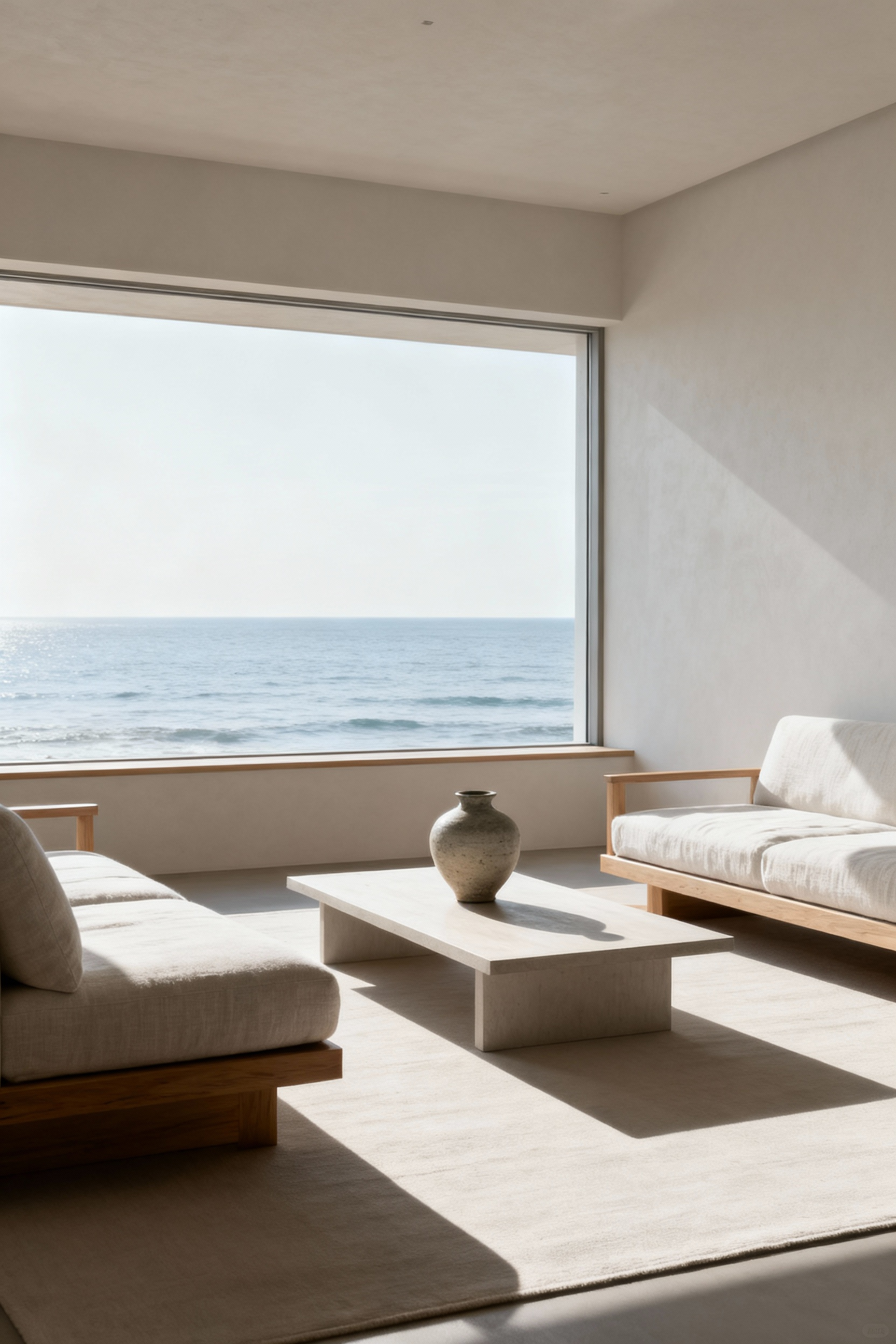
To use negative space effectively, you must be a ruthless editor. It takes courage to leave a wall empty, or to have just one object on a beautiful shelf. But this restraint is where the power lies. The emptiness frames and amplifies the few things you choose to display, giving them significance. In a coastal setting, this openness also allows the primary elements—the light, the view, the sound of the ocean—to take center stage. You are not decorating a room; you are curating an experience of tranquility.
14. Establishing Anchoring Perspectives: Crafting Visual Recesses and Expansive Sightlines
A well-composed room guides the eye on a peaceful journey. We use the principle of shakkei, or “borrowed scenery,” to draw the expansive coastal view into the home, making it the primary focal point. A large, frameless window acts as a living painting, constantly changing with the light and seasons. The entire seating arrangement can be oriented towards this magnificent vista, anchoring the experience of the room.
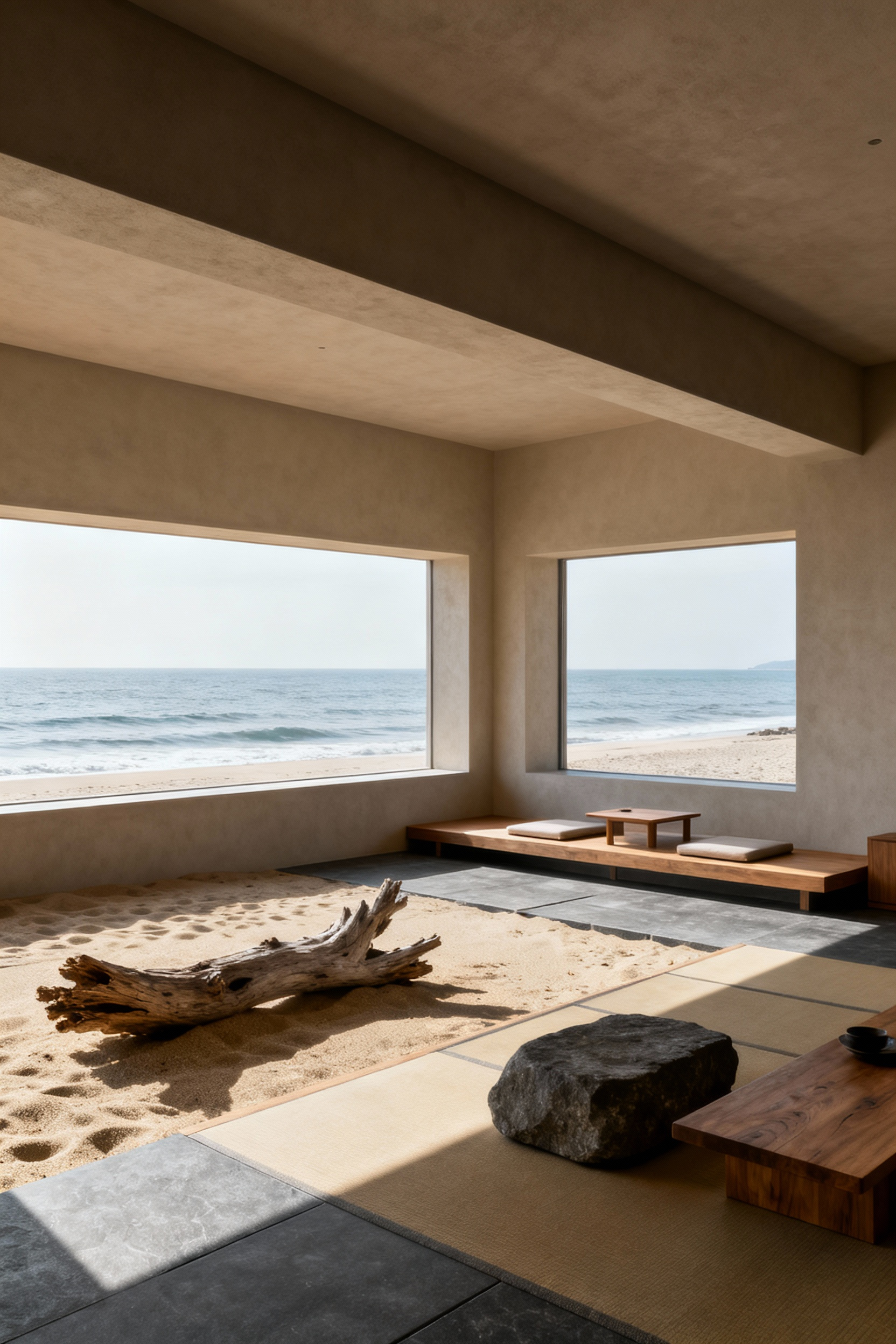
But we must also balance the expansive with the intimate. Alongside these sweeping sightlines, we create small visual recesses, like the tokonoma alcove in a traditional Japanese room. This could be a small niche in the wall for a single vase, or a quiet corner with a comfortable reading chair and a low lamp. These sheltered spots offer a sense of refuge and enclosure, providing a counterpoint to the openness of the sea. This rhythm of expansion and enclosure—looking out and looking in—creates a dynamic and deeply comforting space.
Ma and the Meyasubashi: Artful Delineation and Rhythmic Composition of the Coastal Living Space (Part 2)
As we refine our understanding of space and form, we turn to a subtle but powerful tool: reflection. Used not for vanity but for perception, reflective surfaces can dissolve boundaries and deepen our connection to the surrounding light and landscape, embodying the fluid, ever-changing nature of the coast itself.
15. Integrating Reflective Surfaces Strategically: Augmenting Volume and Diffusing Radiance
In a coastal home, where the sea and sky are boundless, reflective surfaces can be used to borrow that immensity and bring it indoors. This is not about creating a hall of mirrors, but about using reflection to augment the perceived space and diffuse light in a way that feels organic and serene. This practice extends the principle of ma, turning a solid wall into a portal that enhances the sense of openness.
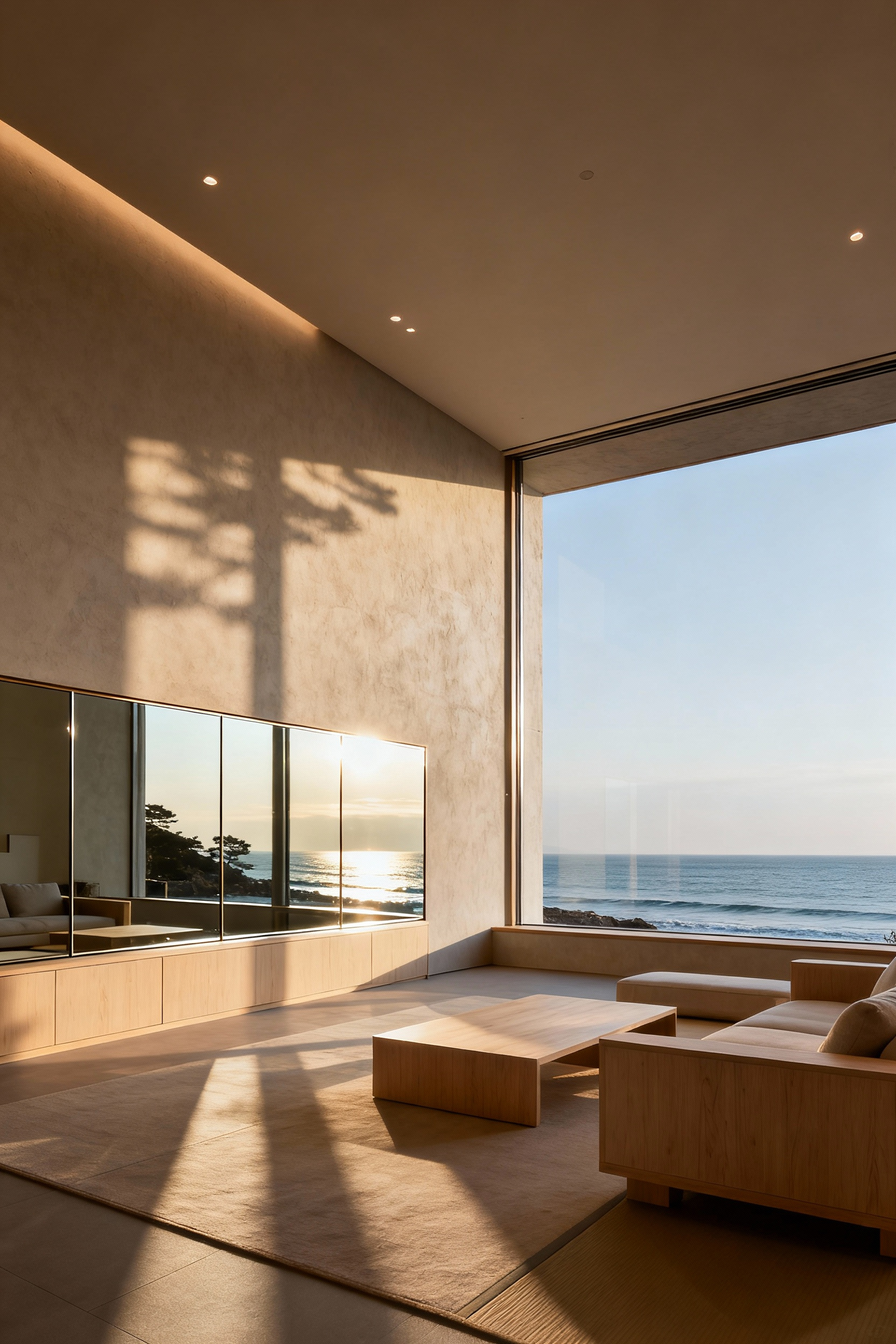
A large, frameless mirror placed opposite a window can do more than just make a room feel bigger; it can effectively pull the entire ocean view inside, dissolving the boundary between interior and exterior. But reflection can be more subtle. Consider the gentle sheen of a lacquered wooden table, which can catch the light with a soft glow rather than a hard glare. From my background in Japanese aesthetics, what’s interesting is how even the surface of water in a simple ceramic bowl can act as a living mirror, reflecting the sky and the shifting light, bringing a dynamic, natural element of reflection into the heart of the room. This strategic use of reflection creates an environment that feels lighter, brighter, and deeply connected to its magnificent surroundings.
Komorebi and Ikigai: Infusing the Living Room with Lived Poetics and Purposeful Serenity (Part 1)
Finally, we arrive at the soul of the space. A room is not complete until it is infused with personal meaning and supports a life of purpose. Here we explore how to curate objects that tell your story (Mitate), how to bring in life itself (Biophilia), and how the space can engage all your senses, fostering a sense of deep well-being and purposeful serenity (Ikigai).
16. Curating Artifacts of Personal Resonance: Elevating Objects to Evoke Narrative (Mitate)
The concept of Mitate invites us to see objects not for what they are, but for what they could represent. A simple, water-worn stone is not just a stone; it is a memory of a walk on the beach, a symbol of endurance, a tactile connection to the power of the ocean. In your coastal living room, you should surround yourself not with decorations, but with artifacts of personal resonance. This is about elevating objects to the level of narrative and memory.
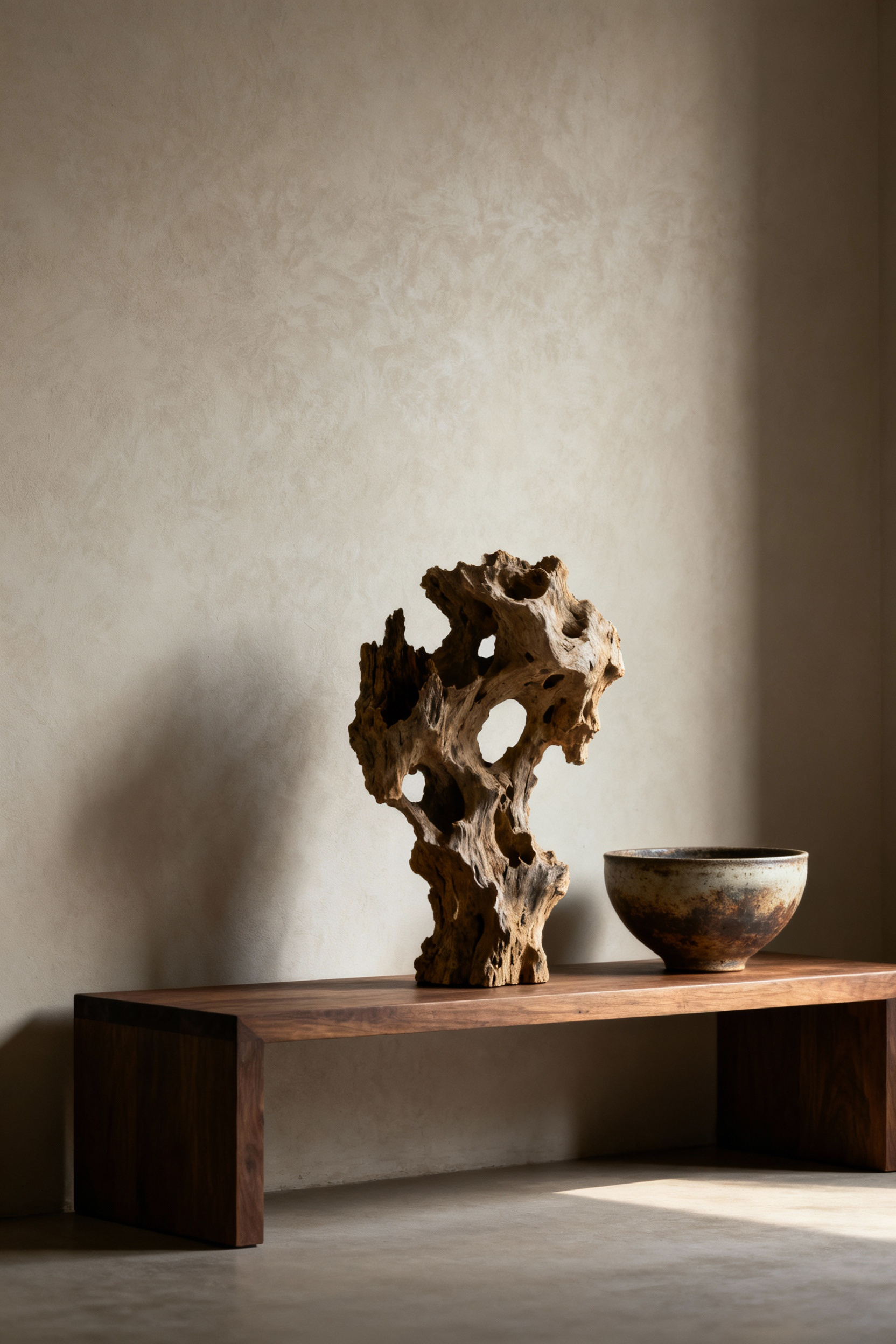
Instead of buying things to fill shelves, collect them slowly over time. A beautiful shell from a family trip, a slightly imperfect ceramic mug from a local artist, a well-loved book with a creased spine. These objects are imbued with stories. Give them a place of honor, with plenty of ma around them, so their presence can be truly felt. This transforms the room from a designed space into a personal sanctuary—a physical manifestation of your life and your memories.
17. Integrating Biophilic Interventions: Strategically Placed Life for Vitality
Our innate connection to nature, or biophilia, is essential to our well-being. Bringing living things into our home is one of the most direct ways to honor this connection. But this is more than just placing a few potted plants around. It’s about thoughtfully integrating verdant life into the fabric of the room to add vitality and to physically improve the air we breathe.

Choose plants with forms that complement the serene aesthetic—a sculptural snake plant, the delicate fronds of a fern, or a simple kokedama moss ball. In Japanese design, we often use a single, elegant branch in a vase to represent the current season. This small act connects the home to the cyclical rhythm of the outside world. Tending to these living things becomes a small, daily ritual—a moment of mindfulness that fosters a relationship of care. A room with living, breathing elements feels vital and nurturing in a way that a static room never can.
18. Harmonizing Olfactory Scapes: Subtle Natural Fragrances for Multi-sensory Immersion
A room’s atmosphere is shaped by more than just what we see. The subtle world of scent can have a profound impact on our mood and sense of peace. Drawing from the tradition of Kodo, the art of appreciating incense, we can harmonize the olfactory scape of the coastal living room. This is not about using artificial air fresheners, but about introducing subtle, natural fragrances that feel authentic to the environment.
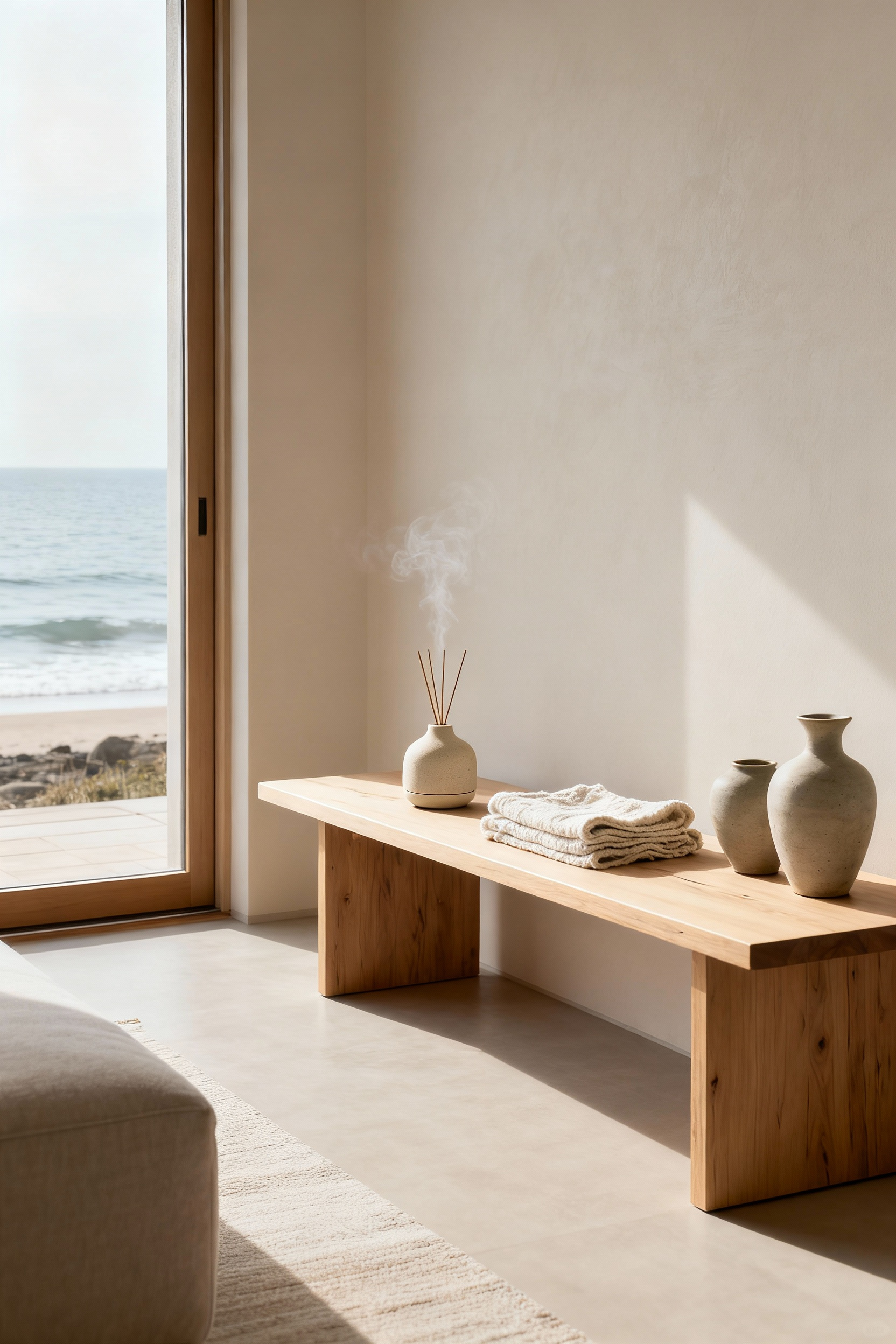
The scent of salty air from an open window is the perfect foundation. You can complement this with the clean, grounding aroma of hinoki wood, perhaps from a small diffuser or a simple block of wood. A few drops of a yuzu or cedarwood essential oil can add another layer. Even the simple act of brewing a pot of green tea can fill the room with a calming fragrance. A space that smells of nature—of wood, plants, and the sea—creates a deeply immersive experience that calms the nervous system and makes the room feel like a true sanctuary.
19. Designing for Seasonal Ephemeral Beauty: Allowing the Room to Respond to Nature’s Rhythms
The most profound sense of serenity comes from accepting and celebrating impermanence. The Japanese concept of Mono no Aware is a gentle awareness of the transient nature of life. A home should not be a static museum; it should be a living space that responds to the rhythms of nature. Designing for this ephemeral beauty means creating a room that can subtly shift with the seasons.

This can be as simple as changing the textiles. In summer, light, airy linens feel appropriate. In winter, a soft wool throw adds warmth and comfort. Keep a special vase that you fill with whatever the season offers: delicate blossoms in spring, vibrant grasses in summer, bare, sculptural branches in winter. What I tell my students is to see their home as a participant in the cycles of nature. This practice fosters a deep mindfulness and connection to the world, reminding us of the quiet beauty that can be found in every fleeting moment.
Komorebi and Ikigai: Infusing the Living Room with Lived Poetics and Purposeful Serenity (Part 2)
As our contemplation comes to a close, we focus on an all-encompassing quality that is felt more than seen. It is the quiet culmination of all these principles—an unobtrusive beauty that doesn’t demand attention but reveals itself slowly, fostering a deep and lasting sense of peace.
20. Fostering Shibui Elegance: Attaining Unobtrusive Beauty Through Subtlety
Shibui is one of our most treasured aesthetic concepts. It describes a type of beauty that is quiet, unobtrusive, and deeply refined. It is not plain or rustic, but rather an elegance so profound it doesn’t need to announce itself. A shibui object or space gets better with age, revealing new layers of depth and meaning over time. It is the opposite of a fleeting trend; it is timeless.

To foster shibui elegance in your coastal living room is to embrace subtlety in all things. It is found in the perfect balance of a simple furniture arrangement, in the masterful craftsmanship of a joint you can barely see, in the subdued harmony of a natural color palette. The room as a whole feels calm and resolved, without any single element crying out for attention. This unobtrusive beauty creates a serene backdrop for life. It is an environment that supports, rather than distracts, allowing you to find your own quiet purpose, your ikigai, within its peaceful embrace.
Conclusion
We have walked a long and contemplative path together, moving from the unseen world of philosophy to the tangible reality of a living space. We have learned that creating a coastal living room through the lens of Japanese aesthetics is not about adopting a style, but about cultivating a feeling—a deep and resonant tranquility. It is the understanding that wabi-sabi allows our homes to be gracefully imperfect, and ma gives our minds the space to breathe.
The true essence of this approach lies in its quietness. By choosing natural materials that tell a story, by composing our spaces with intention and restraint, and by honoring the ever-changing beauty of the coastal light, we create more than a room. We craft a sanctuary. It becomes a space that feels deeply connected to the world outside—to the rhythm of the tides and the expanse of the sky—yet offers a profound sense of shelter and peace within. I hope these thoughts serve as a quiet guide. May you use them not as rules, but as invitations to look more deeply, to choose more thoughtfully, and to create a home that is a true and lasting refuge for the spirit.
